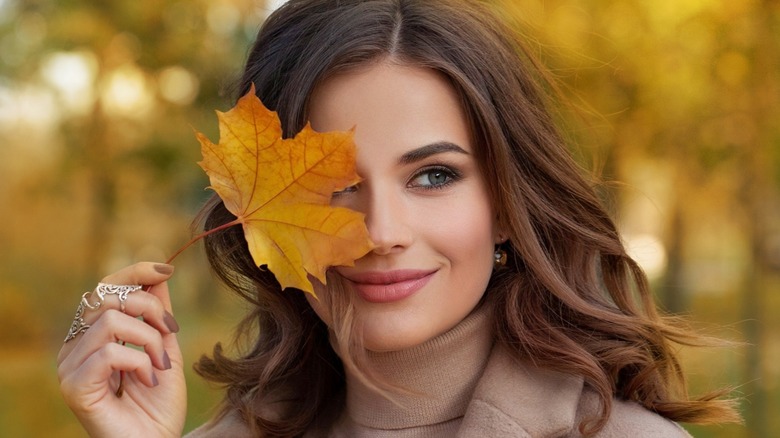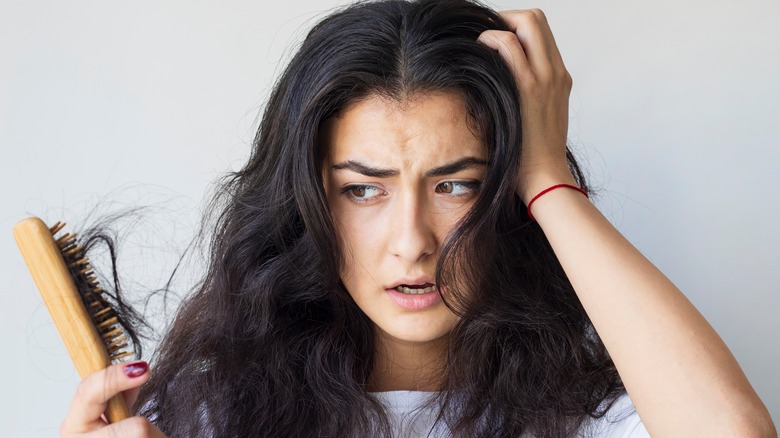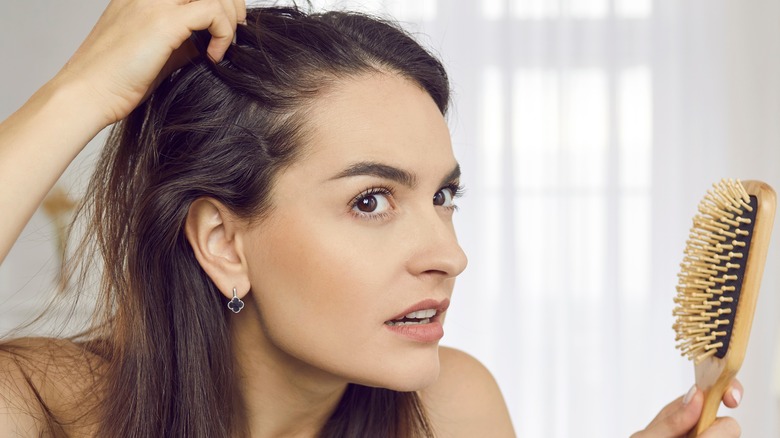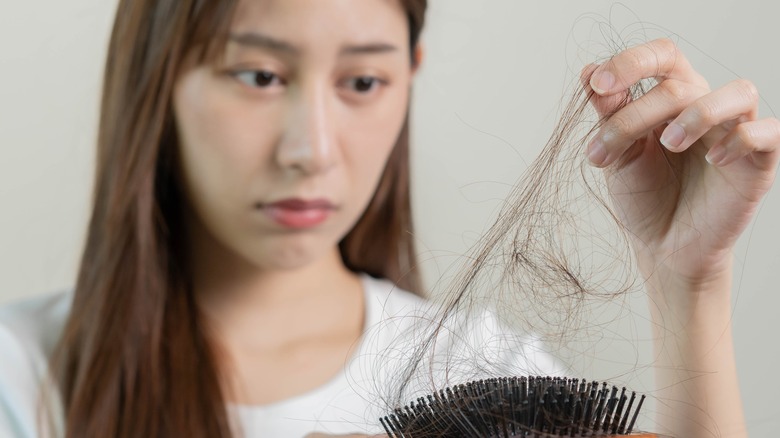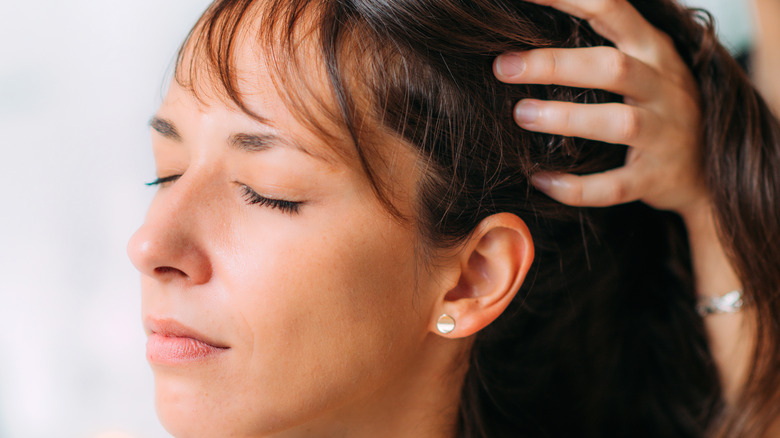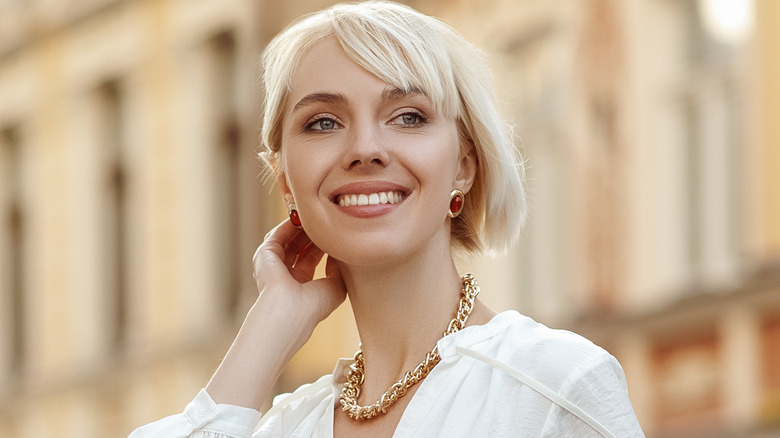Postpartum Bangs Are Yet Another Way Your Body Can Change During Pregnancy
From vaginal discharge to swollen feet to skin discoloration, childbirth can affect a woman's body from the top of her head to the sole of her feet, according to Parents. As far as postpartum physical changes go, an issue that takes a big toll on a new mom's self-image is probably postpartum bangs, which are wispy strands of hair that appear where hair had previously fallen out as a result of pregnancy and postpartum excessive hair shedding. These unruly little tufts of fine hair typically crop up around your hairline and can be difficult to tame. That's why postpartum bangs are also referred to as baby hair.
Now, postpartum bangs, or postpartum hair loss in general, are yet another way your body changes after childbirth. According to the Cleveland Clinic, postpartum hair loss doesn't strike right after child delivery, but usually a few months after childbirth when most other postpartum symptoms have passed. When postpartum bangs hit, you'll find that the hair over your head seems to look thinner, or your hair falls easily as you run your fingers through your locks or wash them. Although it's a hard pill to swallow, it's a perfectly normal part of your perinatal recovery and most new mothers have to go through this phase. If postpartum hair changes bother you, these reassuring facts will help you put your worries to rest and embrace your wispy fringe of postpartum hair regrowth until your hair returns to its normal fullness.
Causes of postpartum bangs
There are three phases to the natural growth cycle of the hair: growing phase (anagen), regressing phase (catagen), and resting phase (telogen). During pregnancy, hormonal changes — such as higher levels of estrogen and progesterone — cause your hair to linger in the growth phase, which causes additional hair growth on various parts of the body, including your scalp, your chest, and your face, according to a study published in Current Topics in Developmental Biology, 2016.
After welcoming your baby into the world, your hormone levels begin to change again as your estrogen levels decline sharply, sending your hair into the resting phase. When hair follicles are finally released from the prolonged growing phase, you'll start seeing increased hair shedding. Albeit alarming, it's just a sign of your hair returning to its natural hair cycle and growing again. Dermatologist Dr. Jenny Liu tells PureWow: "During postpartum, your hair tries to shift back to what it was prior to the pregnancy. Since this is happening all at once, it appears that more hair is being lost and hair is thinning. Over time, our bodies will adjust back to pre-pregnancy and hair will start to grow in as normal." Postpartum bangs — which are signs of hair regrowth — are really a healthy sign if you're currently experiencing postpartum hair loss, Dr. Liu stresses.
Postpartum hair loss is only temporary
Postpartum hair loss stems from sudden changes in hormones in your body, so there's technically nothing you can do to prevent it. But the good news is it doesn't stay forever. Generally speaking, postpartum hair loss is temporary, but its duration might vary from person to person. On average, excessive hair shedding post-baby starts within three months of giving birth and continues for as long as 12 months. The condition usually peaks within four months of giving birth and starts subsiding after that, according to the American Academy of Dermatology. Under usual circumstances, your hair growth should return to its normal rate on your child's first birthday — so there's no need to freak out when you wake up to the sight of hair falling all over your pillows or your hairline has become a nest of unruly Amélie-esque baby fringe.
However, if your hair continues to shed or there's no significant improvement in hair regrowth after the one-year mark, you might want to visit a healthcare professional for an accurate diagnosis, Lancaster General Health warns. Sometimes, extensive thinning on the head might be indicative of an underlying health symptom. Sleep deprivation, thyroid dysfunctions such as an underactive thyroid, and iron deficiency can also inhibit hair growth and contribute to perinatal hair loss.
How much hair do you lose postpartum
When the postpartum phase hits, you can expect to lose up to 300 hair strands per day. Each person has 100,000 hair follicles or more on their scalp. Hair loss of 50 to 100 strands per day doesn't significantly affect a person's appearance and is considered typical, but losing more than 100 hairs per day or 700 hairs per week is considered excessive and may be suggestive of an underlying condition, according to trichologist Iain Sallis for Insider. People with alopecia areata — an autoimmune disorder that causes your hair to shed — might lose up to half or all the hair on their head. Overstyling can also lead to excessive hair shedding and ultimately baldness.
Although postpartum hair loss is often synonymous with falling estrogen levels, physical and emotional stress triggers associated with childbirth also play a part. "If the shedding becomes something that is way beyond what's typical for you, that's what we call telogen effluvium," dermatologist Dr. Simmons-O'Brien tells Hello Giggles. Telogen effluvium is the clinical term for hair loss brought on by a traumatic experience, which explains why it happens so frequently postpartum and affects roughly 30% of new moms.
How to deal with postpartum bangs
Since postpartum hair fall is tied to a hormonal cause, you cannot make it stop immediately. However, you can take measures to lessen the impact of hair loss and make your postpartum bangs grow faster. One approach to minimizing hair loss and facilitating hair growth in new moms is maintaining a healthy diet rich in vitamins and nutrients primarily found in whole grains and vegetables, according to Flo. Iron, vitamin B, vitamin C, vitamin E, and zinc found in many supplements are also great for hair growth.
As far as haircare goes, consider introducing volumizing or hair-thickening shampoos and conditioners designed for fine hair to your beauty routine to encourage postpartum baby hair regrowth, per Cleveland Clinic. Rich in protein and low in conditioning ingredients, volumizing shampoos are useful in adding more body to the hair. If your hair is thinning, avoid washing your hair more than three times per week and focus on washing your scalp instead of your hair ends. When brushing your hair, opt for one with soft bristles and be as gentle as possible. As long as you're dealing with postpartum hair loss, you might want to avoid using hot styling tools to dry or style your hair. Your scalp can easily be inflamed and your hair roots compromised by excessive heat, which can exacerbate hair shedding. If you don't want to wait out the baby hair regrowing phase, you can consult a dermatologist or a trichologist for hair growth treatments.
How to style postpartum bangs
While you wait for your baby bangs to grow out, there are styling hacks you can use to make yourself look good and have more fun during the process. Hairsprays are great for taming baby hairs, hairstylist Kalyani Nayak tells Vogue. For example, you can spritz the formula onto a toothbrush or a wand, and then glide that over the baby hairs to put them down. You can also spritz some more hairspray on your postpartum bangs to lay them flat and brush them out of your face. A simpler option is to just spritz water evenly across your hairline to tamp down the frizz.
If smoothing postpartum bangs is a struggle, you might want to consider a new haircut. "Look for a haircut that can blend the shorter pieces in better to make them look more intentional," hairstylist Amy Stollmeyer tells PureWow. For instance, a pixie cut with very short bangs or a shaggy lob with a face-framing fringe do wonders in accentuating your facial features and giving your overall look a modern, cool-mom touch. Or, you can simply use a hair band to keep those wild postpartum bangs back while adding a funky flair to your new mom look.
